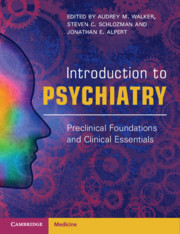Book contents
- Introduction to Psychiatry
- Introduction to Psychiatry
- Copyright page
- Contents
- Contributors
- 1 Introduction
- 2 Clinical Neuroscience
- 3 Introduction to the Patient Interview
- 4 Mood Disorders
- 5 Schizophrenia Spectrum and Other Psychotic Disorders
- 6 Anxiety Disorders
- 7 Obsessive-Compulsive and Related Disorders
- 8 Disorders Related to Stress and Trauma
- 9 Substance Use Disorders
- 10 Personality Disorders
- 11 Neurocognitive Disorders
- 12 Feeding and Eating Disorders
- 13 Child Psychiatry and Neurodevelopmental Disorders
- 14 Sleep Disorders
- 15 Psychopharmacology and Neurotherapeutics
- 16 Psychosocial Interventions
- 17 Psychiatric Evaluation in the Medical Setting
- 18 Psychiatry of Gender and Sexuality
- 19 Health Policy and Population Health in Behavioral Health Care in the United States
- 20 Global Health and Mental Health Care Delivery in Low-Resource Settings
- Index
- References
12 - Feeding and Eating Disorders
Published online by Cambridge University Press: 22 July 2021
- Introduction to Psychiatry
- Introduction to Psychiatry
- Copyright page
- Contents
- Contributors
- 1 Introduction
- 2 Clinical Neuroscience
- 3 Introduction to the Patient Interview
- 4 Mood Disorders
- 5 Schizophrenia Spectrum and Other Psychotic Disorders
- 6 Anxiety Disorders
- 7 Obsessive-Compulsive and Related Disorders
- 8 Disorders Related to Stress and Trauma
- 9 Substance Use Disorders
- 10 Personality Disorders
- 11 Neurocognitive Disorders
- 12 Feeding and Eating Disorders
- 13 Child Psychiatry and Neurodevelopmental Disorders
- 14 Sleep Disorders
- 15 Psychopharmacology and Neurotherapeutics
- 16 Psychosocial Interventions
- 17 Psychiatric Evaluation in the Medical Setting
- 18 Psychiatry of Gender and Sexuality
- 19 Health Policy and Population Health in Behavioral Health Care in the United States
- 20 Global Health and Mental Health Care Delivery in Low-Resource Settings
- Index
- References
Summary
DSM-V describes three eating disorders (anorexia nervosa, bulimia nervosa, and binge eating disorder), three feeding disorders (avoidant/restrictive food intake disorder, pica, and rumination disorder), and two residual feeding and eating disorder categories (APA, 2013). Although these disorders contain some overlapping features, an individual can receive just one feeding or eating disorder diagnosis at a time. The only exception is pica, which can be diagnosed concurrently with another feeding or eating disorder if the pica behavior is severe enough to warrant additional clinical attention.
- Type
- Chapter
- Information
- Introduction to PsychiatryPreclinical Foundations and Clinical Essentials, pp. 289 - 317Publisher: Cambridge University PressPrint publication year: 2021

